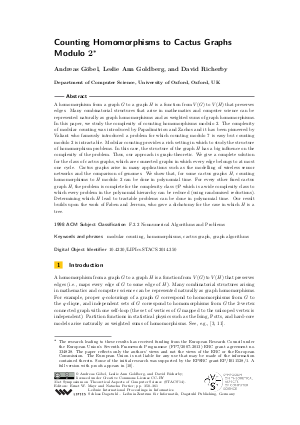Counting Homomorphisms to Cactus Graphs Modulo 2
Authors Andreas Göbel, Leslie Ann Goldberg, David Richerby
-
Part of:
Volume:
31st International Symposium on Theoretical Aspects of Computer Science (STACS 2014)
Part of: Series: Leibniz International Proceedings in Informatics (LIPIcs)
Part of: Conference: Symposium on Theoretical Aspects of Computer Science (STACS) - License:
 Creative Commons Attribution 3.0 Unported license
Creative Commons Attribution 3.0 Unported license
- Publication Date: 2014-03-05
File

PDF
LIPIcs.STACS.2014.350.pdf
- Filesize: 0.59 MB
- 12 pages
Document Identifiers
Subject Classification
Keywords
- modular counting
- homomorphisms
- cactus graph
- graph algorithms
Metrics
- Access Statistics
-
Total Accesses (updated on a weekly basis)
0Document
0Metadata
Abstract
A homomorphism from a graph G to a graph H is a function from V(G) to V(H) that preserves edges. Many combinatorial structures that arise in mathematics and computer science can be represented naturally as graph homomorphisms and as weighted sums of graph homomorphisms. In this paper, we study the complexity of counting homomorphisms modulo 2. The complexity of modular counting was introduced by Papadimitriou and Zachos and it has been pioneered by Valiant who famously introduced a problem for which counting modulo 7 is easy but counting modulo 2 is intractable. Modular counting provides a rich setting in which to study the structure of homomorphism problems. In this case, the structure of the graph H has a big influence on the complexity of the problem. Thus, our approach is graph-theoretic. We give a complete solution for the class of cactus graphs, which are connected graphs in which every edge belongs to at most one cycle. Cactus graphs arise in many applications such as the modelling of wireless sensor networks and the comparison of genomes. We show that, for some cactus graphs H, counting homomorphisms to H modulo 2 can be done in polynomial time. For every other fixed cactus graph H, the problem is complete for the complexity class +P which is a wide complexity class to which every problem in the polynomial hierarchy can be reduced (using randomised reductions). Determining which H lead to tractable problems can be done in polynomial time. Our result builds upon the work of Faben and Jerrum, who gave a dichotomy for the case in which H is a tree.
Cite As Get BibTex
Andreas Göbel, Leslie Ann Goldberg, and David Richerby. Counting Homomorphisms to Cactus Graphs Modulo 2. In 31st International Symposium on Theoretical Aspects of Computer Science (STACS 2014). Leibniz International Proceedings in Informatics (LIPIcs), Volume 25, pp. 350-361, Schloss Dagstuhl – Leibniz-Zentrum für Informatik (2014)
https://doi.org/10.4230/LIPIcs.STACS.2014.350
BibTex
@InProceedings{gobel_et_al:LIPIcs.STACS.2014.350,
author = {G\"{o}bel, Andreas and Goldberg, Leslie Ann and Richerby, David},
title = {{Counting Homomorphisms to Cactus Graphs Modulo 2}},
booktitle = {31st International Symposium on Theoretical Aspects of Computer Science (STACS 2014)},
pages = {350--361},
series = {Leibniz International Proceedings in Informatics (LIPIcs)},
ISBN = {978-3-939897-65-1},
ISSN = {1868-8969},
year = {2014},
volume = {25},
editor = {Mayr, Ernst W. and Portier, Natacha},
publisher = {Schloss Dagstuhl -- Leibniz-Zentrum f{\"u}r Informatik},
address = {Dagstuhl, Germany},
URL = {https://drops.dagstuhl.de/entities/document/10.4230/LIPIcs.STACS.2014.350},
URN = {urn:nbn:de:0030-drops-44700},
doi = {10.4230/LIPIcs.STACS.2014.350},
annote = {Keywords: modular counting, homomorphisms, cactus graph, graph algorithms}
}
